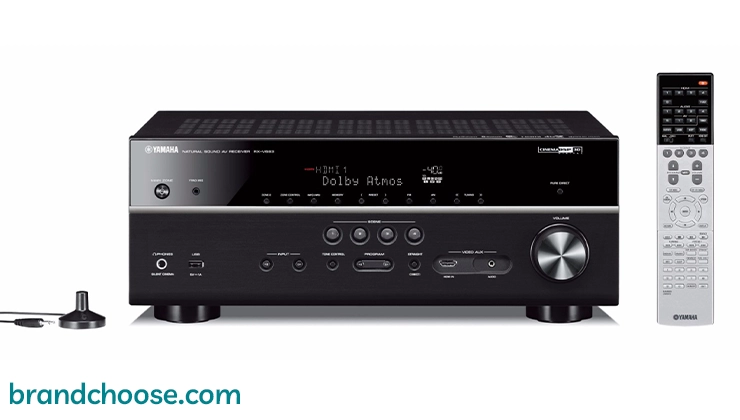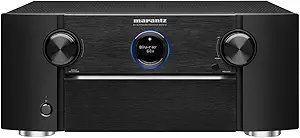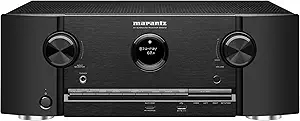
-
Comprehensive connectivity, multi-room audio with HEOS
-
Advanced room calibration with Audyssey MultEQ XT32
-
Advanced control options for custom installations
-
Convenient control from smartphones and tablet
-
Premium build quality and design
-
Future proof video capabilities
Marantz AV Receivers
In the realm of home entertainment, the quest for superior audio experiences drives enthusiasts to explore the world of audio-visual (AV) receivers. Among the myriad of options available, Marantz AV receivers stand out as symbols of innovation, performance, and sophistication. In this article, we embark on a journey to unravel the essence of Marantz AV receivers, uncovering their unique features, advantages, disadvantages, and why they deserve a prominent place in your home theater setup.
Marantz AV receivers epitomize the pinnacle of audio excellence, serving as the cornerstone of your home entertainment system. Meticulously crafted with precision engineering and a dedication to sonic purity, Marantz receivers decode, amplify, and distribute audio signals with unmatched clarity and fidelity. Infused with cutting-edge technology and a legacy of audio innovation, Marantz receivers deliver an immersive listening experience that transcends expectations.
Yamaha AV Receivers
The pursuit of superior audio experiences in home entertainment often leads enthusiasts to delve into the world of Audio-Visual (AV) receivers. Amid a wide range of options, Yamaha AV receivers stand out due to their innovation, performance, and reliability. This article aims to examine the essence of Yamaha AV receivers, discussing their unique features, pros, cons, and why they are a worthy addition to your home theater setup.
Yamaha AV receivers serve as the central component of your home entertainment system. They are expertly designed to decode, amplify, and distribute audio and video signals with precision and clarity. Yamaha receivers, equipped with cutting-edge technology and a history of audio excellence, provide an immersive audio-visual experience that draws you into the heart of the action.

Marantz vs Pioneer – a battle of histories
Pioneer vs Marantz comparison deals with two brands deeply rooted into history, so both of them have improved their merchandise to the remarkable quality e.g. Marantz has five slim and light NR series under $700 with the wireless network (which was done at the first time with the models at such a price). Meanwhile, Pioneer has produced a receiver SX-1980 with dazzling 270W more than 30 years ago even now viable on the market. A Blu-ray player's HDMI output can be easily hooked to it. So, it seems that Pioneer has won in this opposition Marantz vs Pioneer when it launched that powerful receiver.
Marantz – the road to success through improvements

In 1953, a not professional musician Saul Marantz started the company in New York, named after himself, with the preamp device the ‘Consolette’. He immediately launched the Model 1 preamplifier that would be improved through the decades after always remaining an innovative device. The Model 2 already had 20W in triode mode and 40W. The following one, Model 3, had an improved power supply. The Model 7 had innovative for that time preamplifier. The Model 8 produced 2x30W stereo power amp. The improved version 8B had 5Wpc power increase from a circuit base. The Model 9 had 70W and was the first one with a front panel. The Model 10 included the FM.
Due to this desire to improve not only amplifiers but also video quality, the company faced unmitigated success in the 1970s.
No longer after it, Marantz was taken up by Philips for the next 30 years until 2001, when Marantz Japan Inc. became an independent company and united its overseas subsidiaries. In 2017, Denon and Marantz were sold to Sound United Company from America. Despite no longer being an independent company, it still preserves its uniqueness. The factories were left in Japan.
Marantz produced SR Series Home Theater Receiver series that had noticeable higher sound quality with Hyper Dynamic Amplifier Module, the AirPlay that can stream audio directly from iTunes and Spotify or videos from PC. For example, NR1605 from this series has two extra component video inputs, Wi-Fi, Bluetooth, the analog video conversion to HDMI, and a discrete Zone 2 that can be powered through the Surround Back amps in the 7.1 system.
Pioneer – Japanese leadership and the spirit of innovation

In 1938, a predecessor of a future Pioneer Corporation was founded in Tokyo by Nozomu Matsumoto who managed to create the first Japanese Hi-Fi dynamic speaker. Back in times, Pioneer was innovative with its world’s first LD combination player apt to CDs and LDs and the DVD player for professional DJs and VJs. The company produces car audio, automotive navigation systems, televisions, PCs, DVD drives, Misc. DJ equipment. All these merchandises are manufactured in Osaka.
A VSX line has receivers with 80W and 110W per channel. The SC-37 receiver is twice more expensive but with 140W. The new line of in-dash multimedia receivers includes AVH-201EX and AVH-200EX double-DIN 6.2” (the first ones with Bluetooth HFP 1.6 and wideband speech for better sound); a revised panel layout that’s easier to read and a new icon-based GUI and wireless application, dual-band 2.4 and 5.8 GHz WiFi; HDCP 2.2 compatibility and Dolby Atmos.
The Sharp Corporation (9%) and Honda Motor own the dominant shares of the company. In 2014, Onkyo bought Pioneer Home Electronics.
If you’re more into in a comparison chart and would like to compare certain models versus ones from other brands, click on other my receiver comparison.

















